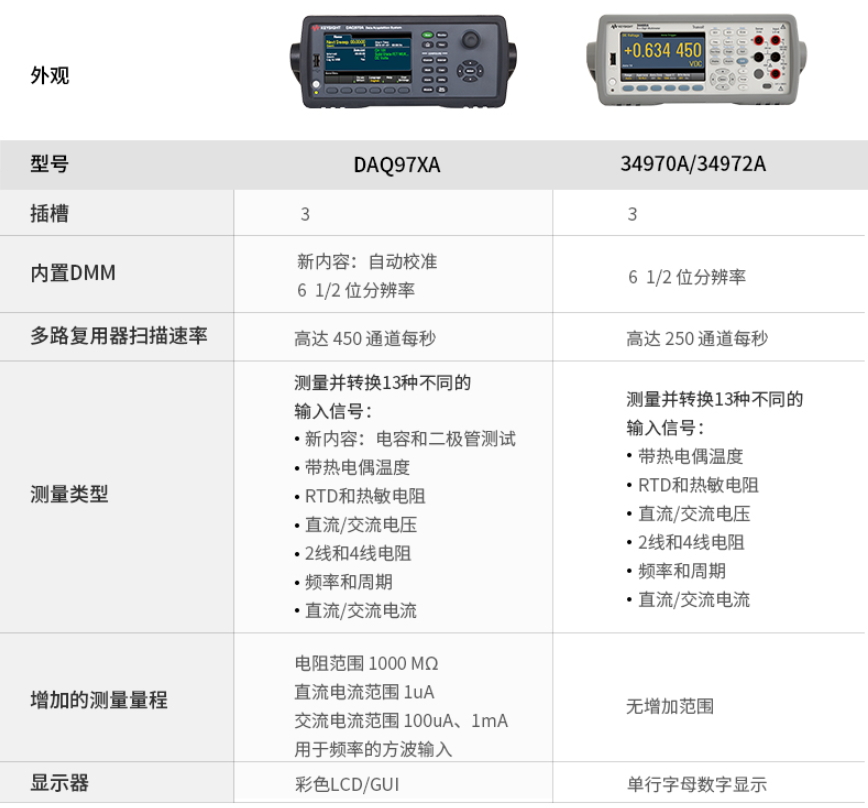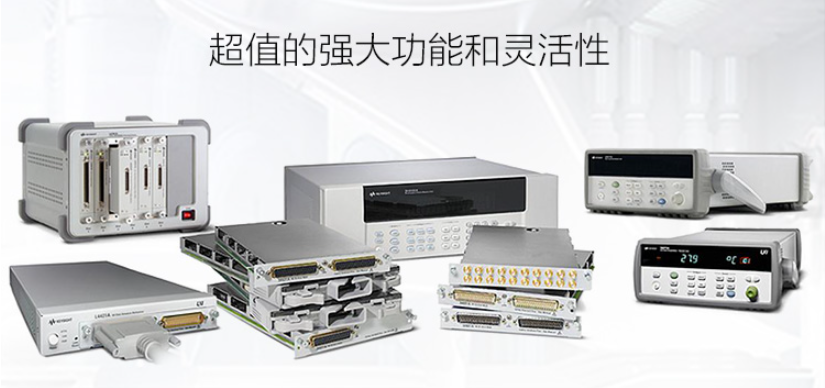Difference between Keysight DAQ970A and 34970A data acquisition instruments?
In modern science and engineering, data acquisition instruments are a key tool for measuring, recording and analyzing a wide range of signals and data. In the data acquisition instrument market, the DAQ970A from DeTech and the 34970A from Keysight (formerly Agilent) are two highly regarded products. This article will compare the main differences between these two data acquisition instruments to help readers choose the right device for their needs.
First, the number and type of channels
DAQ970A has 8 analog input channels and 16 digital input/output channels, which can simultaneously measure up to 8 different analog signals and 16 digital signals. The 34970A, on the other hand, features 3 slots, each of which can be configured for a different type of channel, including analog inputs, digital inputs/outputs, and counter/bus channels. This gives the 34970A the advantage of flexibility in the number and type of channels.

II. Sampling rate and resolution
In terms of sample rate, the DAQ970A has a maximum sample rate of 100 kSa/s, while the 34970A has a maximum sample rate of 100 Sa/s. In addition, the DAQ970A has a 16-bit analog-to-digital converter (ADC) resolution, while the 34970A has 12 bits. Therefore, if a higher sampling rate and higher resolution are required, the DAQ970A may be the more ideal choice.
III. Accuracy and precision
Accuracy and precision are one of the key metrics of a data acquisition instrument. the DAQ970A has a basic accuracy of 0.02% with an internal calibration function that provides higher measurement accuracy. The 34970A, on the other hand, offers a higher basic accuracy of 0.0035%. In addition, the 34970A supports external calibration and auto calibration, providing more accurate measurement results. Therefore, the 34970A is a more suitable choice for applications requiring higher accuracy requirements.

IV. Memory Capacity and Storage
In terms of storage, the DAQ970A has a memory capacity of 1 GB, which can store a large amount of measurement data. On the other hand, the 34970A has a smaller memory capacity of 100 kB. However, the 34970A supports external storage media, such as USB storage devices, for high-capacity data storage.
V. Power Supply
The DAQ970A can be powered via USB or an external power adapter, while the 34970A requires an external power adapter for power supply.
To summarize, there are some differences between DeTech's DAQ970A and Keysight's 34970A in terms of the number of channels, sampling rate, accuracy, memory capacity and power supply. Choosing the right data acquisition instrument depends on your specific needs and application scenarios. If you need more channels, higher sampling rate and accuracy, and high-capacity data storage, consider the DAQ970A, while the 34970A may be a more suitable choice if flexible channel configurations and higher measurement accuracy are more important.

Finally, it is recommended that you consult official documentation or contact the manufacturer for more accurate and detailed specifications before making your selection to ensure that you choose the best data collector for your needs.
In modern science and engineering, data acquisition instruments are a key tool for measuring, recording and analyzing a wide range of signals and data. In the data acquisition instrument market, the DAQ970A from DeTech and the 34970A from Keysight (formerly Agilent) are two highly regarded products. This article will compare the main differences between these two data acquisition instruments to help readers choose the right device for their needs.
First, the number and type of channels
DAQ970A has 8 analog input channels and 16 digital input/output channels, which can simultaneously measure up to 8 different analog signals and 16 digital signals. The 34970A, on the other hand, features 3 slots, each of which can be configured for a different type of channel, including analog inputs, digital inputs/outputs, and counter/bus channels. This gives the 34970A the advantage of flexibility in the number and type of channels.

II. Sampling rate and resolution
In terms of sample rate, the DAQ970A has a maximum sample rate of 100 kSa/s, while the 34970A has a maximum sample rate of 100 Sa/s. In addition, the DAQ970A has a 16-bit analog-to-digital converter (ADC) resolution, while the 34970A has 12 bits. Therefore, if a higher sampling rate and higher resolution are required, the DAQ970A may be the more ideal choice.
III. Accuracy and precision
Accuracy and precision are one of the key metrics of a data acquisition instrument. the DAQ970A has a basic accuracy of 0.02% with an internal calibration function that provides higher measurement accuracy. The 34970A, on the other hand, offers a higher basic accuracy of 0.0035%. In addition, the 34970A supports external calibration and auto calibration, providing more accurate measurement results. Therefore, the 34970A is a more suitable choice for applications requiring higher accuracy requirements.

IV. Memory Capacity and Storage
In terms of storage, the DAQ970A has a memory capacity of 1 GB, which can store a large amount of measurement data. On the other hand, the 34970A has a smaller memory capacity of 100 kB. However, the 34970A supports external storage media, such as USB storage devices, for high-capacity data storage.
V. Power Supply
The DAQ970A can be powered via USB or an external power adapter, while the 34970A requires an external power adapter for power supply.
To summarize, there are some differences between DeTech's DAQ970A and Keysight's 34970A in terms of the number of channels, sampling rate, accuracy, memory capacity and power supply. Choosing the right data acquisition instrument depends on your specific needs and application scenarios. If you need more channels, higher sampling rate and accuracy, and high-capacity data storage, consider the DAQ970A, while the 34970A may be a more suitable choice if flexible channel configurations and higher measurement accuracy are more important.

Finally, it is recommended that you consult official documentation or contact the manufacturer for more accurate and detailed specifications before making your selection to ensure that you choose the best data collector for your needs.







